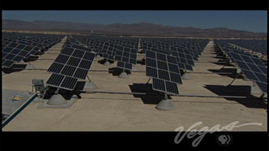As of 2009, the Nellis Solar Power Plant, located on Nellis Air Force Base in Nevada, is the largest solar photovoltaic installation in North America. (The word "photovoltaic" comes from the words photo, meaning "light," and voltaic, meaning "the production of energy.") Operational since 2007, the Nellis array contains approximately 70,000 solar panels and 6 million solar cells. It is capable of producing 14 megawatts of energy, which can generate 25 to 30 million kilowatt-hours of electricity annually. This can supply more than 25 percent of all electrical power used at the base, which is equivalent to the annual needs of about 2,200 homes.
Each panel in a photovoltaic (PV) array contains photovoltaic cells, which are typically made of silicon crystals and directly convert sunlight into electrical energy. When light particles called photons strike a cell, they get absorbed within the crystal. An electric field present in the crystal then separates electrons from positively charged "holes." Positive holes move to one side and electrons to the other, creating a voltage difference between the two regions of the crystal. Voltage is a measure of tension in an electric field that is analogous to pressure in a fluid. Electrons move from positive to negative points, creating a current. This current then flows to the PV cell's output terminals.
The direct current (DC) power generated by PV cells can be stored in batteries. But before it can be used, it must run through an inverter. This device converts DC power into alternating current (AC) power, the form most lighting, motors, and appliances use to run. Photovoltaic energy can be used either near to where it's produced or distributed away from its source. Systems can be connected to an electrical grid to serve broader areas, run independently of a grid to serve local needs, or combine with other electrical systems. The amount of power generated depends on the quantity of photons reaching the cells, which vary according to the time of day, whether clouds are present, and seasonally.
Each year, the Nellis PV array will keep 24,000 tons of carbon dioxide out of the atmosphere—the amount that would be created if the 14 megawatts were coming from a coal-fired plant. That's the equivalent of removing 185,000 cars from the road. The project may also be good for the future of clean and renewable solar energy. As more and more people invest in the technology, its cost should come down, making it more affordable to people and businesses that want to use it.
To learn more about solar technology and its potential uses, check out Photovoltaics, Solar Paint Your Roof, and Solar Car.
To learn more about the ways in which energy is produced and their environmental impacts, check out Solar House.
To learn more about energy use and other renewable energy sources, check out Snapshot of US Energy Use, Energy Sources, Global Warming: Beyond Fossil Fuels, and Geothermal Power.
To learn more about electricity, check out AC / DC: What's the Difference?.
